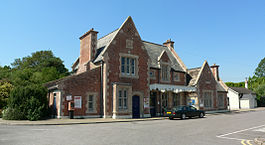Axminster railway station
| Axminster |
|
|---|---|
 |
|
| Location | |
| Place | Axminster |
| Local authority | East Devon |
| Coordinates | 50°46′44″N 3°00′18″W / 50.779°N 3.005°WCoordinates: 50°46′44″N 3°00′18″W / 50.779°N 3.005°W |
| Grid reference | SY292982 |
| Operations | |
| Station code | AXM |
| Managed by | South West Trains |
| Number of platforms | 2 |
| DfT category | D |
| Live arrivals/departures, station information and onward connections from National Rail Enquiries |
|
| Annual rail passenger usage* | |
| 2011/12 |
|
| 2012/13 |
|
| 2013/14 |
|
| 2014/15 |
|
| 2015/16 |
|
| History | |
| Original company | London and South Western Railway |
| Post-grouping | Southern Railway |
| 1860 | Opened |
| 1903 | Lyme Regis branch opened |
| 1965 | Lyme Regis branch closed |
| 1967 | Line singled |
| 2009 | Second platform reopened |
| National Rail – UK railway stations | |
| * Annual estimated passenger usage based on sales of tickets in stated financial year(s) which end or originate at Axminster from Office of Rail and Road statistics. Methodology may vary year on year. | |
|
|
|
Axminster railway station serves the town of Axminster in Devon, England. Opened by the London and South Western Railway (LSWR) in 1860, it is now served by South West Trains’s London Waterloo to Exeter St Davids services on the West of England Main Line . It is 144.5 miles (232.6 km) from Waterloo.
The station was opened on 19 July 1860 when the LSWR opened its Exeter Extension from Yeovil Junction to Exeter Queen Street. The main offices and goods shed were situated on the east side of the line and a small engine shed was provided for the locomotive that was kept here to help trains up the 1 in 80 (1.25%) climb through Seaton Junction to Honiton. A signal box was provided in 1875, situated at the south end of the westbound platform.
Services for many years featured both express trains between London Waterloo and Devon and Cornwall as well as local services between Salisbury or Yeovil and Exeter, but in 1903 Axminster became a junction when the Lyme Regis branch line was opened. A bay platform was built on the west side of the station but the branch climbed a 1 in 80 (1.25%) to cross the main line south of the station by a bridge. There was also a short 1 in 40 connection from the goods yard directly to the branch, but this was removed in 1915. The engine shed was demolished to make room for the new branch, but a new coal stage and water tank was built next to the bay platform. The lever frame in the signal box was extended in 1903 to accommodate the new line, but alterations three years later to accommodate full signalling on the branch required the building to be extended.
In 1923 the LSWR became part of the Southern Railway during the Grouping of 1923. The platforms were lengthened in the 1930s to accommodate longer trains and the new Axminster Carpets factory making Axminster carpets opened alongside the goods yard in 1937.
...
Wikipedia
